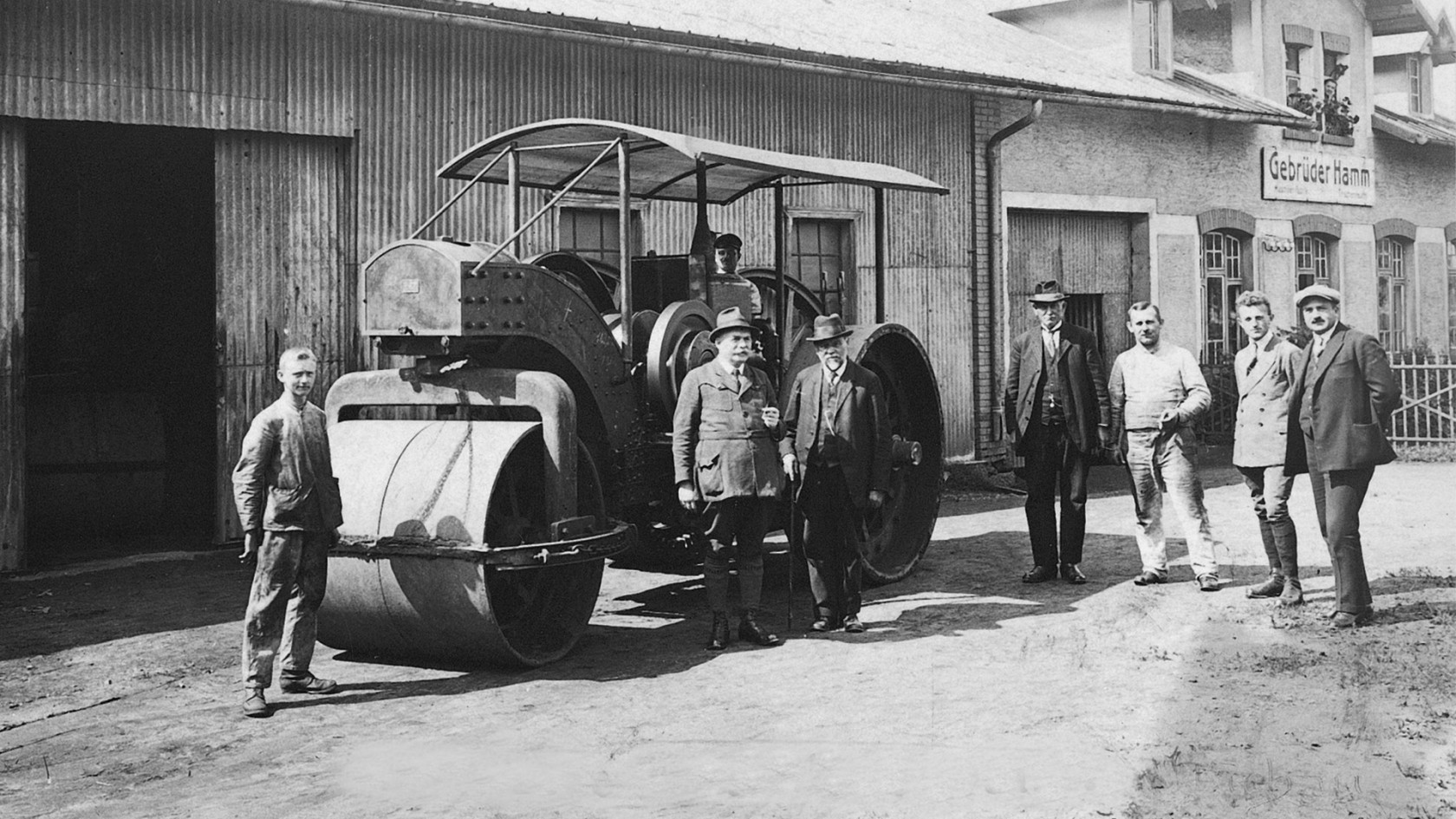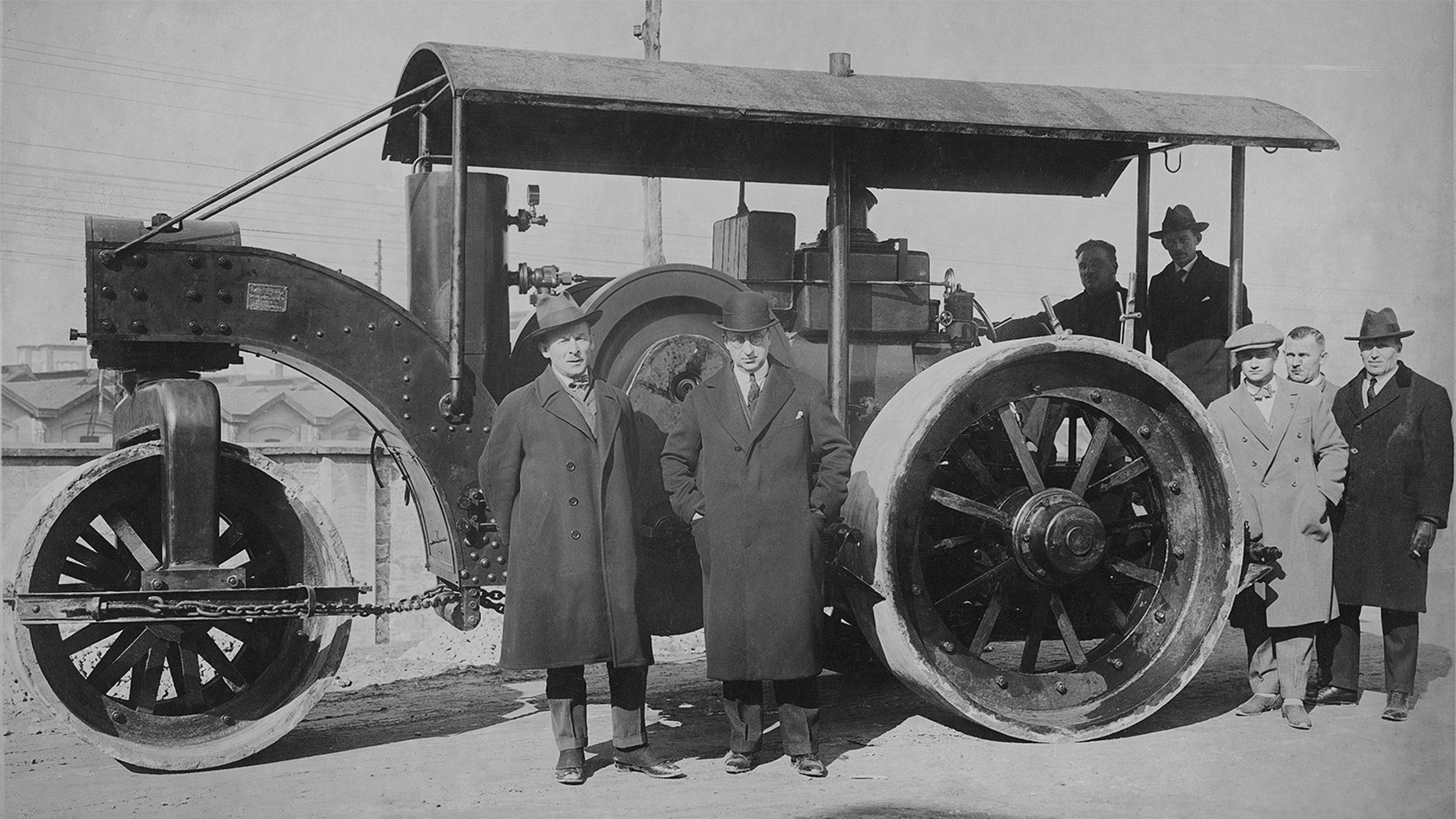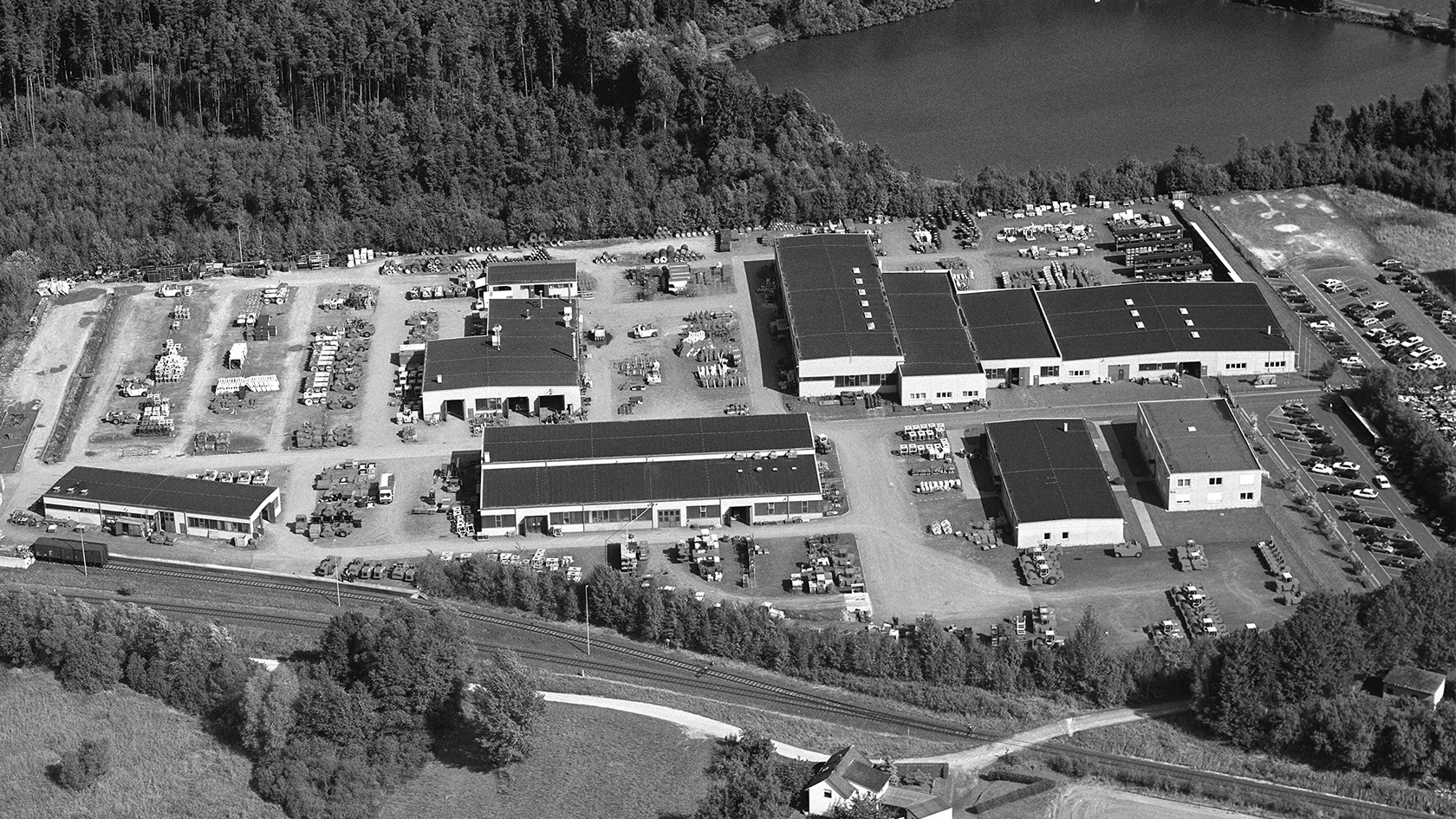

Local roots and internationality
With more than 1,000 employees at its Tirschenreuth HQ, HAMM has long been a permanent fixture of the economy in the north of the Upper Palatinate region. Since it was founded in 1878, two constants have shaped the roller manufacturer's history spanning more than 140 years.
Throughout HAMM's history, there have been various lines that have typified development time and again, and have endured right up to today. In addition to the continual new and ongoing development of technological milestones and ergonomic, contemporary design, these also include the aspects of local roots and internationality.
In the short account below, you will find various historical brands that illustrate the meaning of these two terms for the development of HAMM.
The beginning: Down-to-earth product range
When Franz and Anton Hamm opened their own workshop in Tirschenreuth in 1878, their circumstances were still modest. They produced whatever the customers demanded. Since most of the customers were farmers, at first the little workshop turned out a wide variety of agricultural implements. The Hamm brothers thus played their part in the mechanisation of local agriculture. In the early years, for example, HAMM manufactured machines to power agricultural implements, later motorised threshing sets and even a potato grater. For more than two decades, HAMM remained true to this business model before developing their first road roller in 1911.
1896: First successes – first growth
Moving into the future: With the move to Bahnhofstraße in Tirschenreuth in 1896, HAMM gained a new home that was to remain the company’s head office until 1987. The production of agricultural equipment and machinery was highly successful for the Hamm brothers. However, the modest workshop on Schmellergasse in Tirschenreuth soon reached its capacity limit. HAMM therefore built a new production building in nearby Bahnhofstraße which it was able to occupy in 1896. All orders could now be processed in the modern premises. HAMM remained on Bahnhofstraße for almost ninety years, before moving into the current premises on Hammstraße in 1987.
1914: First foreign trade
Thanks to the invention of the world's first motorised road roller, HAMM also began to attract interest from abroad. The First World War put international success on hold for a while, however. The development of the first motorised road roller in 1911 represented a milestone in road construction technology. It was therefore unsurprising that the new invention from Tirschenreuth rapidly attracted foreign interest. In summer 1914, a Dutch customer ordered one of the first road rollers produced by HAMM. Enquiries had already been received in Tirschenreuth from other potential customers. On 3rd August 1914 however, the First World War swept across the European continent. Trade relations with foreign countries were broken off. Even business with the Dutch company was suspended.
The Weimar period: European and overseas customers put their faith in HAMM motorised road rollers
From Tirschenreuth to the entire world: The international breakthrough for HAMM came after the First World War. Motorised road rollers were supplied to all four corners of the globe. During the 1920s, Germany slowly recovered from the consequences of the First World War. HAMM concentrated on the production of a motorised road roller. The first documented export sale occurred in April 1924: The records show that HAMM delivered the first motorised road roller to Austria. In the 1920s and 1930s, the export share grew to 34 percent. HAMM road rollers were delivered to Italy, the Netherlands, France, Romania and Switzerland. One particular order for the Tirschenreuth-based company was received from a former war-time enemy: The French Republic ordered 30 motorised road rollers for use in Guadeloupe and its colonies in Indochina.
Even though HAMM enjoyed great international success from the 1920s onwards and was able to build on this success story once again after 1945, the regional market remained of particular importance. Two thirds of the road rollers sold in Germany was supplied by HAMM to customers in Bavaria. Bavarian authorities and companies remained the most important customers for road rollers until well into the 1960s. Despite the many international successes, HAMM remained firmly rooted in its local community.
In 2021, the Wirtgen Group will celebrate 60 years of Wirtgen. Time to take a look back and a look ahead. Vögele, Hamm, Kleemann, and Benninghoven have also played a leading role in shaping the industry’s technologies.
> Road Construction History1948: HAMM in the reconstruction period
From reconstruction to economic miracle: For HAMM too, the first post-war years were difficult. Once again, it was the regional customers who got the company back on its feet in the post-war period. With the emerging economic miracle, HAMM became a global player. At the end of the war in 1945, the German economy was on its knees and a functional infrastructure was virtually non-existent. At HAMM too, it took some time to get production up and running again. For its first major job in the post-war era, HAMM owed a debt of gratitude to a regional customer: The Munich Reichsbahnzentralamt, precursor to the Deutsche Bahn (German Railways), bought almost half of the HAMM rollers produced at the time for the reconstruction of the rail infrastructure. As the German economic miracle progressed, HAMM's production figures continued to grow strongly.
A new beginning for exports: Italy, the most important foreign market
During the 1950s, HAMM's export sales also increased significantly. By the middle of the decade, exports reached the 50 percent mark. When the German economic miracle led to a general recovery in the 1950s, HAMM once again conquered the international market. The road rollers from Tirschenreuth enjoyed great success especially in Italy, thanks not least to the enterprising Italian sales representative Mario Ferrari. By the mid-1950s, exports exceeded the 50 percent mark for the first time. This time, however, the company was not satisfied with just the European market. The road rollers from Tirschenreuth developed into a worldwide export hit and were shipped as far away as Brazil, Indonesia, El Salvador and Afghanistan. Thus HAMM successfully re-embarked on its international journey.
International trade fairs: Important catalyst for sales
Presenting one's own products to an international audience is vitally important, especially in the engineering area. For this reason, HAMM has had a presence at numerous trade fairs in Germany and abroad for many decades. Participation in trade fairs and exhibitions was very important for HAMM's business even in the early years. From the 1950s onwards, HAMM road rollers were also showcased at numerous international trade fairs. The Tirschenreuth-based company was represented at trade fairs in Milan, Paris, Barcelona and Las Vegas. However, the most important construction machinery trade fair continues to be bauma in Munich. HAMM is the only company to have had an uninterrupted presence there since its inauguration in 1954.
Production of HAMM rollers abroad and under licence
The HAMM road roller was not only built in Tirschenreuth, but also under licence in Italy, Japan and Czechoslovakia. Their sophisticated technology and reliability helped the rollers become internationally established. But not every HAMM road roller has its origins in Tirschenreuth. HAMM did not only rely on exports. From the mid-1950s, HAMM rollers were built in collaboration with a partner in Italy. Licences to build the rollers were awarded to SAKAI in Japan in the 1960s and to Stavostroj in Czechoslovakia in the 1970s.
The 1970s: Upheavals in difficult times
In the 1970s, the family-owned company HAMM had to be sold. This step was forced upon the Hamm brothers by the bad business decisions in the course of manufacturing swivel bending machines and equipment for chamfering, cutting and bending metallic materials. In the mid-1980s, Umberto Draghi led the company back on the path to success. HAMM is an important economic factor and employer for the entire Tirschenreuth region. Entire families have been and continue to be associated with the company for decades and generations. If you worked for HAMM, you were known in German as a "Hammerer". It therefore hit the region all the harder when HAMM found itself in a precarious situation in the 1970s as a result of poor business decisions, and the Hamm brothers were forced to sell their company. Not even the new owner IBH was able to steer HAMM into calmer waters. A worldwide crisis in the construction industry also impacted strongly on the IBH Group, which was forced to file for bankruptcy under Hans-Dieter Esch in 1983. In Esch’s time, IBH Holding was regarded as one of the largest construction machinery groups in the world. It was not until Umberto Draghi took over the company in 1984 that HAMM's fortunes took a turn for the better. Draghi was also instrumental in the decision to concentrate the company in the Wagnerholz industrial zone and the neighbouring Franz-Heldmann-Straße in Tirschenreuth. In order to boost capacity, however, the Bahnhofsstraße premises were retained for the time being.
1987: A new start with a new plant
After almost 90 years on Bahnhofstrasse, HAMM finally moved into modern new factory premises on Hammstraße in 1987 – the dawn of a new era. Under the stewardship of Umberto Draghi as well, HAMM remained a Tirschenreuth company. And thus true to its roots and the region. Modern production and administration buildings were built on the site at the present Hammstraße. This marked the end of an era after almost 90 years on Bahnhofstraße. Since then, the factory premises have continued to experience constant growth.
Wirtgen Group – concentrated expertise in road construction
New highlights: The involvement of Wirtgen GmbH in HAMM in 1999 marks the start of a new chapter in HAMM's ongoing success story. In 1999, Wirtgen GmbH from Windhagen in Rhineland-Palatinate acquires a majority shareholding in HAMM AG. Within the Wirtgen Group, HAMM is the third major manufacturer alongside Vögele (road pavers) and Wirtgen (road milling machines). The product of this alliance is concentrated expertise in road construction. HAMM's product range perfectly complements the existing Wirtgen Group portfolio. The worldwide sales and service network offers HAMM new development potential, calling for larger and modern production halls right from the outset. Thanks to what was the largest single investment within the Wirtgen Group at that time, the topping-out ceremony for the new plant is celebrated in September 2001. In 2005, the Wirtgen Group achieved its targeted position as world market leader in self-propelled road building machines. A position that it holds successfully to this day.
A new era with far-reaching prospects – HAMM AG becomes part of John Deere
In June 2017, the Wirtgen Group and John Deere merged, and HAMM was once more integrated into a corporate group association. "In terms of the future, we chose John Deere quite specifically, because the company is interested in the long-term success of the Wirtgen Group and supports our employees worldwide," explained the two managing directors Jürgen and Stefan Wirtgen in June 2017, making the reasoning for their decision clear. A sale with guaranteed prospects for all companies and brands in the association. The takeover was completed in full in December 2017. But it was not a new start under completely new auspices. John Deere builds on continuity and long-term partnerships in all corporate sectors. In addition, the US and Palatine corporate group combines solid joint values and a corporate culture that is shaped by local roots, mutual respect and long-term prospects, as well as quality, passion, innovation and customer orientation. Being under the umbrella of John Deere also allowed HAMM to strengthen its position in terms of its earthwork range. The prospects were good – even under a new umbrella, a successful future was awaiting HAMM.

